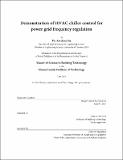Demonstration of HVAC chiller control for power grid frequency regulation
Author(s)
Su, Po-An (Po-An Leo)
DownloadFull printable version (24.67Mb)
Alternative title
Demonstration of heating, ventilation and air conditioning chiller control for power grid frequency regulation
Other Contributors
Massachusetts Institute of Technology. Department of Architecture.
Advisor
Leslie K. Norford.
Terms of use
Metadata
Show full item recordAbstract
Secondary frequency regulation is a necessary electric grid ancillary service that balances electric power system supply and demand on short time intervals of seconds to minutes. Commercial HVAC chillers may be well positioned to provide secondary frequency regulation as a demand side resource. Commercial 200 ton (703 kWth) chillers serving two buildings in the Boston area are used to experimentally develop a practical closed-loop controller that modifies chiller power demand to provide secondary frequency regulation. In the first setup, a physical controller is connected directly to the chiller and adjusts power through chilled water setpoint. In the second setup, both the chiller and air handling units are controlled through the BAS. Demonstrations using standard electric system operator test routines show the chiller power response to exceed qualification requirements while providing up to +/-25% of chiller nameplate power in secondary frequency regulation capability. The controller is further demonstrated to provide secondary frequency regulation continuously for several hours longer than the standard test routines, during which building cooling load changes significantly. Analysis of results indicate minimum power and variable COP as two factors that could be incorporated into future models to more accurately reflect observed chiller transient behaviour and predict performance. BAS communication delays, ramp rate limits, and compressor cycling are additional factors that can have significant negative impacts on controller performance. Extrapolation of experiment results to higher-level analysis indicates that chillers can contribute to the secondary frequency regulation requirements at the grid level in aggregate, although potential varies greatly depending on climate and building type. There is more potential in the south, where 21% of secondary frequency regulation requirements might be met with chillers; the contribution of chillers in colder climates is minimal. Short-term power balance to achieve stability is essential for the operation of the modern electrical power system. Providing stability through modified control of existing HVAC chillers in commercial buildings is a technologically feasible alternative to existing solutions and can make a meaningful contribution to the electrical grid.
Description
Thesis: S.M. in Building Technology, Massachusetts Institute of Technology, Department of Architecture, 2015. Cataloged from student-submitted PDF version of thesis. Includes bibliographical references (pages 74-77).
Date issued
2015Department
Massachusetts Institute of Technology. Department of ArchitecturePublisher
Massachusetts Institute of Technology
Keywords
Architecture.